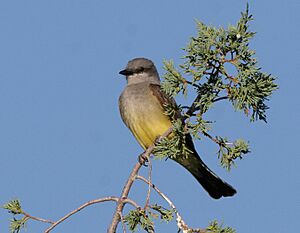Western kingbird facts for kids
Quick facts for kids Western kingbird |
|
|---|---|
 |
|
| Conservation status | |
| Scientific classification | |
| Genus: |
Tyrannus
|
| Species: |
verticalis
|
 |
|
The western kingbird (Tyrannus verticalis) is a medium-sized bird known for its strong personality. It's a type of tyrant flycatcher, and you can find it in western North America, even down to Mexico.
Adult western kingbirds have gray and yellow feathers. They also have a secret patch of bright red feathers on their head, which they usually keep hidden. They only show these red feathers when they are trying to attract a mate or scare away other birds. Like other kingbirds, the western kingbird is very protective of its space.
Sometimes, people confuse the western kingbird with other kingbirds that also have yellow colors, like Cassin's Kingbird or the Tropical Kingbird. But you can tell the western kingbird apart by its black, square-shaped tail, which has a white edge on the outside.

Contents
What Does a Western Kingbird Look Like?
Western kingbirds are about the size of a robin. They have a sleek body shape that helps them fly quickly to catch insects. Their colors help them blend in with their surroundings, especially when they are perched on branches or wires.
| How Big Are They? | |
|---|---|
| Length | 8–9.3 in (200–240 mm) |
| Weight | 40 g (1.4 oz) |
| Wingspan | 15.5 in (390 mm) |
Where Do Western Kingbirds Live?
Western kingbirds like to live in open areas across western North America. They often choose places with scattered trees or shrubs. Over the last 100 years, more trees have grown in the Great Plains. This has helped the western kingbird, and many other birds, spread to new areas.
These birds are often seen perched on fences, power lines, or the tops of trees. From these high spots, they can watch for food and keep an eye on their territory.
What Do Western Kingbirds Eat?
Western kingbirds are mostly insect eaters. They are very good at catching bugs in mid-air. They will wait on an open perch and then fly out quickly to grab insects like bees, flies, winged ants, spiders, and grasshoppers.
They also eat some plant foods. You might see them munching on berries, buckthorn, sumac, or even poison ivy seeds.
Western Kingbird Behavior and Life Cycle
The name "kingbird" comes from how bossy and brave these birds are. They are known for being very aggressive when defending their territory. They will even chase away much larger birds, like hawks! If they think their young are in danger, they might even attack humans or pets.
Nesting and Young Birds
Western kingbirds build a strong, cup-shaped nest. They usually place their nests in trees or shrubs. Sometimes, they will build them on top of poles or other man-made structures.
A female kingbird lays three to five eggs. The eggs can be white, creamy, or pinkish, with dark spots of brown, black, or lavender. The parents take turns sitting on the eggs for about 12 to 14 days until they hatch.
Baby kingbirds grow very quickly. Their nests are quite small, so sometimes the growing chicks get pushed out of the nest before they are fully ready to fly.
Migration
When the weather gets cold, western kingbirds fly south. They travel in groups to warmer places like Florida and the Pacific coast of southern Mexico and Central America. They return north when spring arrives to breed again.
What Does a Western Kingbird Sound Like?
The song of a western kingbird sounds like a squeaky chatter. Some people say it sounds like a squeaky toy! Their call is a sharp, loud "whit." Sometimes, you can even hear them singing before the sun comes up.
Images for kids
See also
 In Spanish: Tirano occidental para niños
In Spanish: Tirano occidental para niños




